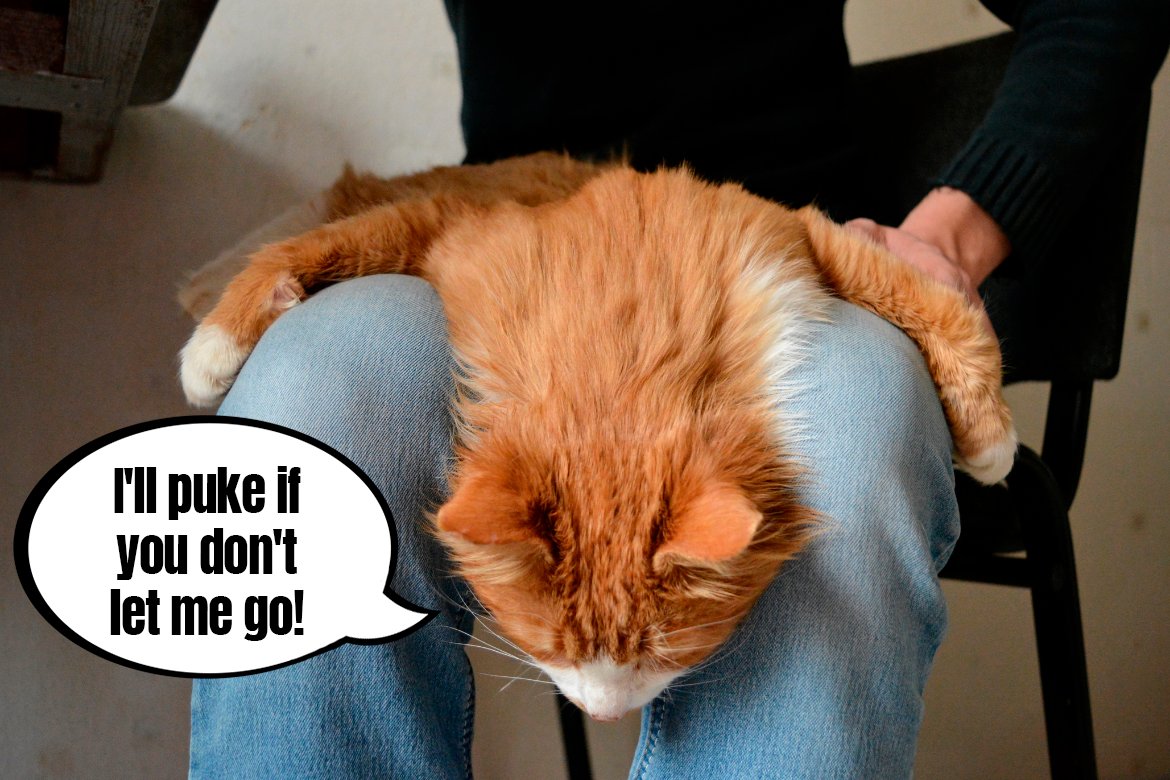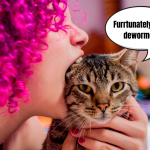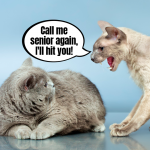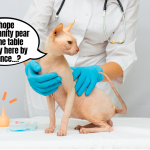An artistic puke left as a gift in the middle of the living room? A slippery surprise in the bathroom, just for you to step into on your nightly trip for a pee? A charming vomit on a freshly washed pillow? Who doesn’t know it, right? For a cat Carer experienced in puke wars it’s no surprise – a quick reaction with a cloth and it’s over. But let’s remember, fabCats, that cat vomiting can make us worried, especially if it happens quite often and goes hand in hand with refusing to eat or other symptoms. When should we be worried about our cat’s health when it comes to puking and going to the vets as quickly as possible?
Start with observation
Kitty accidents aren’t usually a coincidence – when a cat throws up, their body has to have a reason to clean itself from anything that’s inside their digestive system. It’s important that we observe our pet from once the first, worrying symptoms start showing and think about what could be causing the issue. There’s a big chance it’s just a one-time thing – we all know that fresh grass is a great snack and it can create a beautiful, green puke. But there are situations where cat’s vomiting is a clear sign to visit the vet quickly. How to recognise them?
What to look out for?
Every time your cat happens to have a vomiting accident, it’s good to answer a few questions in your mind to help you pinpoint the cause of the issue and possibly help to find the right treatment at the vet clinic. The most important of them are:
- Frequency of vomiting,
- Timing – does it happen after a meal, after eating cat grass, or maybe it’s completely unrelated to food?,
- Health condition – is your cat treated for anything, or do they visit the vet only for their annual jabs and deworming? When was the last time your cat was given a deworming treatment or any other medication?,
- How it looks – we know that the sight of fresh cat puke is not pleasant at all, but it’s good to check what’s inside them (water, partially digested food, bile, parts of plants, hairballs, or maybe blood?),
- Circumstances – besides connecting it with feeding time, it’s good to figure out if your cat has recently had their food changed (type of food, flavor) or if they showed any symptoms of food allergies before,
- Other symptoms: diarrhea, weakness, apathy, lack of appetite, but also symptoms that are not connected with the digestive system, like losing fur, coughing or neurological issues.
While a one-time vomit with grass or a hairball is not a reason to be worried (that is, as long as it doesn’t bring any other symptoms with it and doesn’t repeat often), throwing up because of the food your cat ate, the medication they’re given or when there are other symptoms may be a sign of more serious health issues.
Find the cause for your cat throwing up
At this stage we must underline one important thing, dear fabCats – we’re never recommending you to self-diagnose your animals look for the answers online, when the symptoms are clearly alarming and require doctors assistance. In our lifetime, we’ve already said goodbye to two cats – Louis and Figo and we know how tempting it is to look for answers on the internet. However, nothing can replace a quick consultation with a specialist – with Louis, we knew about his vital signs getting worse, but Figo took us completely by surprise. We never waited to see what happens – when there were any worrying symptoms, our vet was the first line of help and this is the road of looking for your cat’s health issues we always recommend. However, it’s also good to read about things, to educate yourself and to want to know more, as you never know when such knowledge can come in handy. Just leave the diagnosing and decisions about certain treatment options to the specialists.
What we do recommend is trying to find the cause of your cat throwing up in the cat’s home environment. Finding it can make it easier to act quickly and get the right diagnosis, while often pointing out the elements of the environment that should be preventively removed. Here are some of the most common reasons of cats puking:
- Hairballs. It’s completely normal – when cats clean themselves, they swallow quite a lot of fur every day. Throwing up lets them get rid of the hairballs forming in their digestive tract and – depending on the cat – it can happen very often or almost never. Individual predispositions, diet, as well as preventative supplementing of products that help with the hairballs are among the most common factors that affect your cat’s puking habits.
P.S. If your cats are eating grass which irritates their guts and helps with removing hairballs from the digestive tract, their puke may contain hair, hairballs with grass or grass pieces only.
- Allergies and food intolerances. Some cats simply don’t do well on certain types of meat and food, making vomiting one of the first signs to analyse your cat’s diet. With food intolerances, throwing up usually happens right after the meal and it can go together with diarrhea as well. We recommend discussing the matter with a cat dietitian or a veterinarian.
- Poisoning. This one requires immediate help from a specialist – cats can digest something poisonous that can quickly deteriorate their health and lead to the most tragic results. Throwing up is usually simultaneous with lack of appetite, weakness, apathy, irritability, but also hiding from the Carer and generally feeling low. As cat Guardians, we need to make sure our cats don’t have access to things harmful to their health (chemicals, plants etc.), just to minimize the risk.
- Swallowing a foreign object. Cats love chewing on grass and plants, but also on things that are not necessarily good to chew on. Those can include strings, ribbons, small toy parts, but also plastic, paper, wrappers and other things. Never induce vomiting by yourself – if you know your cat has eaten something and tries to throw it up (or does throw up, but the piece doesn’t come out), only a veterinarian, using an RTG or USG imaging, will be able to locate the item and give proper medication to induce vomiting or, in more difficult cases, to do a procedure to remove it surgically.
Other causes for cat vomiting include a wide variety of health issues – from those of little harm, easily solved with proper medication (e.g. deworming), to the tough ones which are difficult to diagnose and even more difficult to treat. If you don’t know what could’ve caused your cat to throw up, even if it was a singular event, a vet visit is your safest option.
Saving the scratchers – how to clean up your cat’s accidents?
As a little bonus, we have for you, fabCats, a quick tip on how to clean cat “accidents” from difficult areas – a category our cardboard scratchers definitely fit into. Cardboard doesn’t like wetness that much, so cleaning it with a damp cloth is out of the picture! Our tried and true solution is to remove the stain with a dry cloth, a sponge or a paper towel as quickly as possible and leave it to dry on its own. The fronts of the scratchers can be gently cleaned with a lightly damp cloth or a sponge and the entire scratcher can be disinfected (sprayed from afar) with products designed for that purpose or with a high percent alcohol, like the one used to clean electronics, as it evaporates very quickly. Just BE CAREFUL with spraying, as every drop of liquid – even the one that evaporates immediately – will leave a little stain on the cardboard. And, of course – the battle wounds will be visible on the cardboard even when it’s all dry, but the scratcher will be fully usable and ready for cats to get crazy again.
Remember that the rest of myKotty products – like our cardboard MIA cat house or our cat beds – are easily cleaned as well. The MIA cat house is covered with a layer of smooth cardboard, so it can be cleaned like the fronts of our scratchers (which we described earlier). As far as cat beds go, they all have a washing instruction sewn in on the inside. No cat puke can surprise us 🙂
Do your cats have such unexpected accidents, fabCats? How do you react then? Share your stories in the comments and if you’re in the middle of facing a cat health crisis – stay strong! We’re crossing our fingers for your furs 🙂




